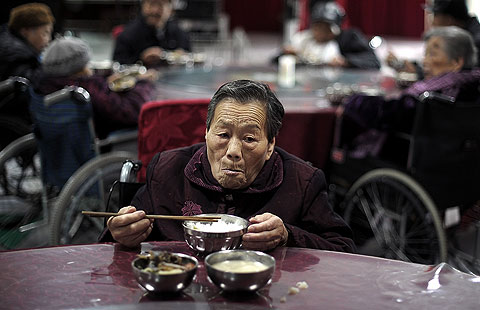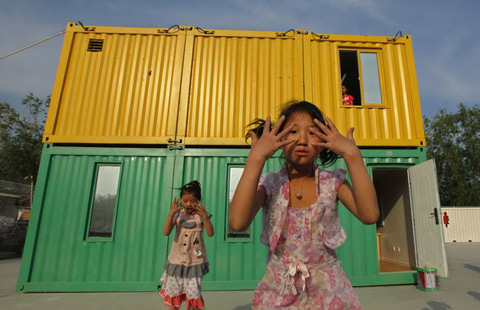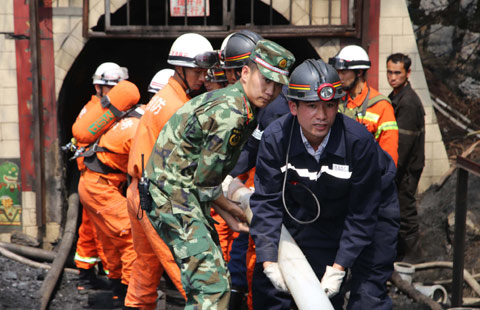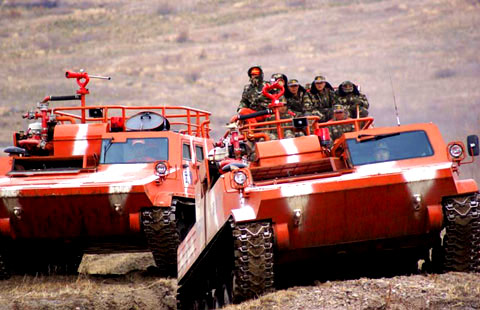Beijing dust storm expected to linger until Sunday
Updated: 2014-04-11 08:20
By Zheng Xin (China Daily)
|
|||||||||||
The dust storm that has enshrouded the Chinese capital since Wednesday night won't disperse until Sunday, the city's environmental watchdog said.
Beijing was hit by another wave of floating dust and sand on Thursday, with the intensity of PM10 (particulate matter with a diameter smaller than 10 micrograms) reaching 595 micrograms per cubic meter in the southwestern part of the city, and 496 downtown.
According to the Beijing Environmental Monitoring Center, the sandstorm originated in the northeastern part of the Inner Mongolia autonomous region and has lingered in Beijing due to the slow wind speed close to the ground.
The Beijing Environmental Protection Bureau warned the public to take precautions when going outside.
The amount of pollutants discharged in the capital last year was much greater than the environment could handle, with PM2.5 exceeding standards, according to a 2013 Beijing Environment Bulletin released by the bureau on Thursday.
PM2.5 is particulate matter with a diameter smaller than 2.5 micrograms that is extremely harmful to health.
Despite efforts to curb pollution, the bureau said in the report that the quality of the capital's environment in 2013 remained almost the same as that of the previous year.
Liu Xianshu, director of the environmental monitoring department of the Beijing Environmental Protection Bureau, said there is a gap between air quality in the southern and northern parts of the city.
According to the bulletin, the PM2.5 in the capital has an average annual intensity of 89.5 micrograms per cubic meter, 156 percent higher than the standard.
"The average PM2.5 index monitored in the north was 60.3 micrograms per cubic meter last year, while it stood at 116.3 in the south, about twice the amount of the north," Liu said.
The average index of nitrogen dioxide and PM10 was 56 and 108.1 micrograms per cubic meter, exceeding the national standards by 40 and 54 percent. The daily maximum eight-hour average ozone concentration exceeded the standard by 14.6 percent.
Among all the six pollutants monitored in the city, only the index for sulfur dioxide and carbon monoxide met the standards last year.
The rapid urbanization and population growth has seriously affected the city's ecological system, he said.
The monitoring stations in high-traffic areas witness a much greater PM2.5 intensity, while some mountainous regions in the northern and western suburbs have better air and water quality.
Liu said the government will add more trees, grassland and wetland in the capital and replace some industrial land with forests.
zhengxin@chinadaily.com.cn
|
 |
 |
|
Students practice in dome inflated with purified air in Beijing |
Related Stories
State Grid upgrades aim to reduce haze 2014-03-28 06:55
Running through the haze becomes first Chinese lesson 2014-03-27 08:34
Living in a haze 2014-03-19 07:39
Root out haze and push forward reforms 2014-03-06 09:25
Zhang Gong: Conducting law enforcement cooperation for haze control 2014-01-21 16:43
Today's Top News
Putin instructs lenient gas policy with Ukraine
World leaders join Weibo
Campaign to save Moscow tower
21 injured in US school knife attack
China to spend more on railways
G20 to focus on boosting economy, not Crimea
RMB to be global reserve currency
US slashes Iran's pick for UN envoy
Hot Topics
Lunar probe , China growth forecasts, Emission rules get tougher, China seen through 'colored lens', International board,
Editor's Picks

|

|

|

|

|

|





